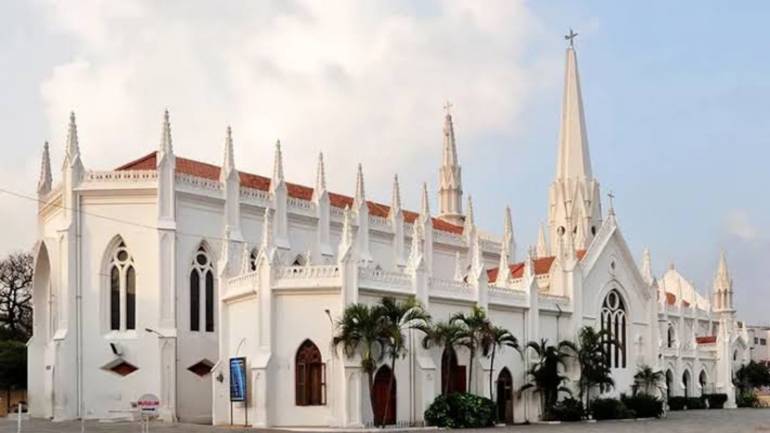St. Thomas Cathedral Basilica: Built Over the Tomb of the First Evangelist in India

St. Thomas Cathedral Basilica stands as a testament to centuries of history, faith, and architectural splendor.
St. Thomas Cathedral Basilica, a magnificent church located in Mylapore, Chennai, stands as a testament to centuries of history, faith, and architectural splendor. This revered site marks the burial place of Thomas the Apostle, who brought Christianity to India.
The church, originally founded by Portuguese explorers in 1523, has evolved through various phases of construction and renovation, reflecting the rich tapestry of its historical and religious significance.
The Portuguese Discovery and Construction
This magnificent church was built over the tomb of Thomas the Apostle, who died in Chennai and whose body was buried in Mylapore.
Portuguese explorers founded it in 1523 after sailing to India following Vasco de Gama's discovery of a sea route in the 15th century AD, which contributed to the further spread of Christianity in the Indian subcontinent.
First, the Portuguese searched for the remains of Thomas. Then they built a church over it. They built a church in his honor.
Thomas was the first to introduce Christianity in India.
British rule led to the reconstruction of the church in 1896. The architects gave it a neo-Gothic design.
Known as St. Thomas Cathedral Basilica, Teak wood was harnessed in the construction of its vault ceiling, providing the classic dark texture.
Sixteen windows ventilate the interior. One of the 34 stained glass panels depicts Thomas touching Christ's wound. This particular stained glass panel is located over the altar. Other stained glass panels depict the apostles.
On the main altar, there is an image of Christ.
The church's nave measures 122 feet long and 33 feet wide.
Architectural Evolution and British Influence
Two spires support the cathedral. The one with a higher elevation—183 feet tall—is located on the left side of the church's entrance.
This spire, visible from a distance, serves as a guide for locating the cathedral. At the same time, it is the church's bell tower.
The other spire was built, rising from the center of the cathedral. Its position tells the people where Thomas' tomb is located below.
The cathedral has a museum to keep religious collections safe. This museum houses the lance head that took Thomas' life.
The cathedral also has a small theater. In this theater, a film narrates the life of an apostle.
Following modern renovations, this church also boasts two chapels. One of the chapels was built below the ground; it houses Thomas' tomb.
Marco Polo, the famous Venetian explorer, merchant, and writer, visited this tomb in 1292.
He wrote in his travel diary:
"The Christians who go thither in pilgrimage take of the earth from the place where the saint was killed (or buried) and give a portion thereof to anyone who is sick of a quartan or a tertian fever; and by the power of God and of St. Thomas, the sick man is incontinently cured."
St. Francis Xavier also lived in the presbytery of the old version of this church in 1545, before he sailed to Taiwan (formerly Ilha Formosa, which means 'beautiful island' in the Portuguese tongue) for a mission. Francis was heavily involved in the Catholic missions in Portuguese India, and he led the first mission to Japan.
Pope Paul V elevated the church to the status of a cathedral in 1606. Pope Paul V also created the Diocese of St. Thomas of Mylapore.
Da Silva, the first bishop of the Archdiocese of India, consecrated the church in 1896.
Historical Significance and Modern Recognition
In 1954, Pope Pius XII elevated the church to the status of basilica minor.
Pope Paul II visited this church in 1986.
In 2006, the church was declared national shrine by the Catholic Conference Bishops of India.
Also known as Santhome Church, this cathedral is one of the only three churches built over the tomb of an apostle. The one is the St. Peter's Basilica in Rome (over the tomb of St.Peter); the other in the Santiago de Compostela Cathedral in Spain (over the tomb of St. James).
Thomas sailed to Malabar, the southwestern region of the Indian subcontinent, in AD 52 to spread the Good News, making him the first to introduce Christianity in India. He died in Chennai (formerly Madras) a martyr in AD 72.
The small Mount St. Thomas Church stands on a small hill over a cave near the cathedral. Thomas hid himself in this place after he was attacked with a spear. He escaped to another hill, known as St. Thomas Mount, through the cave opening.
Thomas is the patron saint of India. His feast is celebrated on July 3 as Christians' Day in India.
Also known as Doubting Thomas, Thomas is mentioned in the historical traditions of churches in Southeast Asia and the Middle East as the evangelist who established their churches.
In the books and traditions of the Syrian Christians of India, Thomas was mentioned to have traveled to China, then back to India.
The German Protestant theologian and writer Kurt E. Koch believed Thomas sailed to Indonesia with Indian traders.
St. Thomas Cathedral Basilica stands as a monumental symbol of the spread of Christianity in India, marking the final resting place of Thomas the Apostle.
From its Portuguese origins to its British architectural influences and modern-day recognition, the church embodies a rich historical legacy.
As one of only three churches built over the tomb of an apostle, it continues to attract pilgrims and visitors, celebrating its enduring spiritual and cultural significance.








